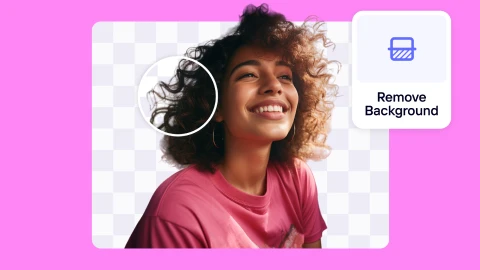Photoroom vs Picsart: which tool is better for e-commerce?
If you’re here, you’re likely weighing your options between Photoroom and Picsart, two of the most popular tools for editing product photos and creating e-commerce visuals. You’ve tried the free plans, maybe even paid for a month, and now you’re asking: which one actually fits my workflow?
This article will help you decide. You'll learn how each tool performs for real e-commerce use cases—from background removal and batch editing to AI tools and output quality. This comprehensive comparison focuses on what matters most for your business: speed, consistency, image quality, and better sales results.
Let’s dive in.
Table of contents:
What is Photoroom?

Its core features—background removal, instant shadows, AI-generated backgrounds, and batch editing—are designed to simplify product listing prep for platforms like Shopify, Etsy, and Amazon.
Unlike general-purpose photo editors, Photoroom focuses on clean, brand-ready visuals, offering templates and powerful AI tools tailored to marketplace standards. It’s available on iOS, Android, and web, with a simple interface that prioritizes speed and consistency over complex design flexibility.
What is Picsart?

Popular with influencers, designers, and hobbyists, it combines AI-powered features like background removal and generative image tools with a massive library of templates, stickers, fonts, and effects.
Picsart is ideal if you want to customize visuals with flair—whether you're creating social posts, ads, collages, or digital art. Available on mobile and desktop, it supports both casual and advanced editing needs across a broad creative audience.
Photoroom vs. Picsart: side-by-side comparison
Both Photoroom and Picsart offer powerful image editing capabilities, but they were built for different users with different goals.
Below, we compare how each platform performs across the areas that matter most for e-commerce sellers. We’ll start with core features and move through to comparing workflows, AI tools, export quality, and pricing.
Feature/Category | Photoroom | Picsart |
Core features | Background removal, product templates, instant shadows, e-commerce-focused UI | Broad creative suite, templates for social/video, drawing tools, stickers |
Batch editing and workflow | Batch edit up to 50 images with templates; optimized for speed and catalog consistency | Batch edit up to 50 images; better for custom design variation |
AI tools and smart features | AI backgrounds, shadows, expand; designed to automate listing prep | AI Replace, text-to-image, style transfer; ideal for creative exploration |
Ease of use | Simple, guided, beginner-friendly; fast onboarding; one-click tools to edit and enhance product photos | Rich UI with more tools and complexity; better for experienced creators |
Output and export options | High-res JPG/PNG/WebP, transparent backgrounds, 250 free exports/month, no watermark | JPG/PNG/WebP, transparent exports |
Pricing and plans | Free (250 exports), Pro: $89.99/yr, Teams: 3 seats included | Free (limited AI), Plus: $90/yr, Pro: $110/yr, per user licensing |
Core feature comparison
Photoroom and Picsart both cover the basics: background removal, cropping, and mobile-friendly editing. But their core strengths reflect very different goals. Photoroom is optimized for e-commerce tasks—with strengths in creating fast, clean, consistent product images—while Picsart is built for creative versatility, from social content to full-blown design projects.
Shared core features:
AI-powered background removal
Mobile and desktop editing
Filters, crop/resize, and standard adjustments
Access to templates (though for different purposes)
Where Photoroom excels:
Purpose-built for e-commerce visuals
Instant background removal with crisp, accurate cutouts
Auto-generated shadows and white backgrounds
Automatic image resizing for e-commerce marketplaces and standard web sizes
Clean UI designed for quick, repeatable product edits
Advanced generative AI features to create new backgrounds and image compositions alongside your product image
AI Expand, AI Upscale, and AI Retouch to enhance the quality of existing images
“Photoroom is known for its AI-powered background removal feature, allowing me to easily and accurately remove backgrounds from photos. This provides me with a quick and efficient way to edit photos, particularly when it comes to background removal—the accuracy of background removal, makes the process smoother and more precise.” — ASHIKA B., G2 Review
Where Picsart excels:
Full creative suite beyond just product photos
Thousands of design templates for social, video, and marketing
Artistic tools like brushes, overlays, and stickers
One-tap video tools and animated content features
Strong fit for creators managing brand visuals beyond e-commerce
“I like that Picsart has so many templates and photo editing tools that help me in fixing, adjusting and helping to make my photos extra special. Great tools for photo editing for family photos and social media. The tools are very easy to utilize to implement what you need for your work.” — Angelo B., G2 Review
Bottom line: If your priority is creating high-quality product images fast, Photoroom offers a streamlined, e-commerce-first experience. If you’re looking for creative flexibility to build stylized marketing or social assets, Picsart gives you more tools to work with, but with added complexity.
Batch editing and workflow speed
If you're managing dozens—or even hundreds—of product photos and listings, the ability to edit in bulk is a major time-saver. Both Photoroom and Picsart support batch editing, but they approach it differently in terms of speed, automation, and use case alignment.
Photoroom: built for speed and scale
Batch editing is available on the Pro plan
Edit up to 50 images at once with background removal, cropping, and templates or consider Photoroom's API if you need to edit larger batches
Apply consistent branding and layout using custom templates
Designed for e-commerce workflows, and perfect for updating product catalogs
Saves you house on creating consistent PDP (product detail page) images

Batch editing is available on the Pro plan
Also supports up to 50 images in a single batch
Can apply edits like crop, resize, background removal, and watermark
Stronger for visual customization than standardized outputs
Workflow can feel slower or less guided for marketplace prep
Bottom line: If you're editing product images in volume, Photoroom’s batch tools are tailored to e-commerce needs, with templates and automation to speed up repetitive tasks. Picsart can handle bulk edits too, but it’s better suited to creatives who want more control over design variation.
AI tools and smart features
AI powers many of the standout photo editing tools in both platforms, but the way these features are applied differs significantly. Photoroom's AI helps you automate and speed up e-commerce photo editing and visual asset creation, while Picsart leans into AI for visual creativity and artistic effects.
Photoroom’s AI strengths:
AI Backgrounds. Instantly generate photorealistic backgrounds tailored to product listings.
AI Shadows. Automatically adds realistic drop shadows to make products pop.
AI Expand. Enlarges the image canvas without cropping or distortion
Product-first AI logic. Designed to enhance and stage listings, not just beautify images.

AI Replace allows you to swap or modify objects in photos using text prompts.
Text-to-image generation for stylized backgrounds or artistic assets.
Style transfer and visual filters powered by generative AI.
Offers more control for creating branded, highly stylized visuals.
Bottom line: Photoroom’s AI helps automate listing prep and polish product shots with minimal input. Picsart’s AI is more exploratory with tools to experiment with style, composition, and design concepts.
User experience and ease of use
Usability is a big factor, especially if you’re not a designer. While both apps are mobile-friendly and well-reviewed for accessibility, Photoroom focuses on simplicity and speed, whereas Picsart’s broader feature set can feel more complex to navigate.

Clean, guided interface with minimal clutter
Tools organized by e-commerce use cases
Automated sizing is available for e-commerce marketplaces and standard web formats
Users say it’s “easy, fast, and intuitive—even for beginners”
Picsart: designed for creative flexibility
Feature-rich UI with multiple menus and editing layers
Thousands of templates and assets can overwhelm you
Great for those familiar with design workflows or social media editing
Users appreciate the customization, but some report “lag” or decision fatigue
Bottom line: Photoroom offers a smoother, faster onboarding experience, particularly if you're looking to improve e-commerce sales. Picsart offers more creative freedom, but with a steeper learning curve and occasional usability trade-offs.
Output quality and export options
When it comes to delivering polished, platform-ready images, output quality and flexibility are key. Both tools allow high-resolution exports and support common file types, but each tool's handling of watermarks, transparency, and export limits can make a big difference, especially if you're working at scale.
Photoroom: optimized for e-commerce output
High-resolution exports in JPG, PNG, and WebP formats
Transparent background support on all plans
Free plan includes 250 monthly exports with no watermark
Pro plan removes all watermarking and unlocks unlimited exports
Fixed and custom sizing options to instantly re-size for e-commerce marketplaces and standard web formats
Resizing is available for single exports and batch exports (for Pro users)
Import photos from Dropbox, Google Drive, iCloud, and OneDrive
Ability to save to your gallery, share a link to the image, or send the image from your device
Picsart: creative flexibility with cloud storage
Exports in JPG, PNG, and WebP formats
Transparent background exports are available on all plans
No watermark on free exports, but AI usage and export features are limited
Cloud storage included (5GB for Plus, 20GB for Pro)
Better for mixed media (e.g., social posts, print files, video frames)
Bottom line: Photoroom ensures your images are marketplace-ready out of the box, with export options and sizes aligned to e-commerce platforms. It also makes it easy to save and share your images in a few clicks, so your team can access them across devices. Picsart offers the same level of versatility across media types and offers cloud storage capabilities, but may require more manual tweaking to hit e-commerce standards.
Pricing and plans
While both tools offer free versions and multiple paid tiers, the structure and overall value differ significantly. Photoroom’s pricing is lean, simple, and focused on e-commerce, while Picsart’s plans support broader creative needs, but at a higher cost.
Photoroom plans:
Free plan: 250 monthly exports, full access to background remover, watermark-free
Pro plan: $12.99/month or $89.99/year
Unlimited high-res exports
Access to all AI tools (backgrounds, shadows, expand)
Batch editing up to 50 images
Teams plan: Includes 3 seats for the price of one ($89.99/year total)
Adds shared templates, brand kit, and group billing
Enterprise plan: custom pricing
Develop scalable workflows that are custom to your organization’s needs
Great for large-scale e-commerce clients
Learn more about Photoroom’s pricing plans here.
Picsart plans:
Free plan: Basic photo/video editing, 5 AI credits per week, 100MB cloud storage
Plus plan: $7.50/month (billed annually)
200 AI credits/month, premium content library
5GB cloud storage
Pro plan: $9.16/month (billed annually)
500 AI credits/month
Unlimited background removals, batch editing, 20GB storage
Brand kit and commercial use license
Bottom line: Photoroom offers stronger e-commerce value at a lower price point, especially if you're a solo seller or have a small team. With Pro, you can use all the AI tools on an unlimited basis, rather than being constrained by monthly credit limits. Photoroom’s team plan is particularly generous, allowing three users for the cost of one. Picsart provides more creative assets and design flexibility, but its credit system and higher cost make it a better fit for design-heavy workflows.
Use cases for Photoroom and Picsart
While both tools have broad appeal, their real-world fit depends heavily on your goals.
If you manage e-commerce product listings across marketplaces like Etsy, Amazon, or Shopify, Photoroom consistently delivers faster, more reliable results.
Its tools are built to streamline high-volume editing, from batch background removal to branded templates that fit platform specs out of the box. If your workflow involves prepping dozens of SKUs or maintaining a consistent visual identity across listings, Photoroom’s speed and e-commerce focus are hard to beat.
Picsart, by contrast, is a stronger match for creators prioritizing social content and brand storytelling. Influencers, designers, and marketers who want more control over layout, text overlays, video, and creative effects will find its features more flexible, but also more complex.
In short: if you're selling products, Photoroom helps you get them online faster, with less friction. If you're promoting a lifestyle or building a visual brand across channels, Picsart gives you more freedom to design, but may slow you down when it comes to listing-ready output.
Use case | Photoroom | Picsart |
Solo e-commerce seller prepping listings | ✅ Optimized for speed, background removal, and clean product visuals | ❌ Overkill; tools may distract from listing-focused tasks |
Marketplace seller with high photo volume | ✅ Batch editing for 50+ SKUs; product templates, and fast exports | ⚠ Supports batch edits but lacks e-commerce-focused automation |
Small brand managing product imagery and ads | ✅ Great for consistent PDP images, basic ad formats, and quick branding | ✅ Better for stylized content and marketing visuals with custom assets |
Social-first content creator or influencer | ⚠ Limited design/sticker/text features; better for product close-ups | ✅ Thousands of creative tools, effects, stickers, and social templates |
Creative agency or designer creating mixed assets | ⚠Limited for advanced layouts, multi-step edits, or video | ✅ Strong fit for multi-channel campaigns and advanced visuals |
Non-designer who wants fast, intuitive tools | ✅ Clean UI, guided templates, minimal setup needed | ⚠ Rich features but steeper learning curve; can feel overwhelming |
Teams or small businesses with shared workflows | ✅ $89.99/yr includes 3 seats, shared templates, and brand kits | ❌ Requires individual licenses for each user; higher total cost; users are constrained by monthly AI credit limits |
Final verdict: choose the best platform based on your needs
Both Photoroom and Picsart are powerful tools, but they serve different goals. If your priority is creating high-quality product images quickly, Photoroom’s e-commerce-first design makes it the clear choice. With batch editing, marketplace-ready templates, and AI tools that streamline listing prep, it’s built to save you time while maintaining a polished brand look.
Picsart, meanwhile, is a better fit if you need creative flexibility; it's better for influencers, marketers, or designers crafting social-first content. Its rich library of effects and templates supports more stylized, experimental visuals.
Ultimately, it comes down to your workflow. If you're looking to optimize efficiency and e-commerce visual consistency, Photoroom offers the most focused, reliable solution.




Design your next great image
Whether you're selling, promoting, or posting, bring your idea to life with a design that stands out.
















